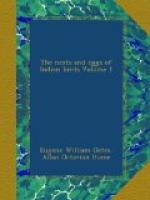At Dacca Colonel Tytler found them nesting in temples and houses about the sepoy lines.
Mr. J.R. Cripps tells us that at Furreedpore, in Bengal, this species is “pretty common, and a permanent resident. This species associates with A. tristis, but is seen on trees away from villages, which the latter never is. Prefers well-wooded country, whereas A. tristis never goes into jungle. On the 29th of June, 1877, I found a nest in a hole of a tree, about 12 feet off the ground. The diameter of the entrance-hole was two and a half inches, and inside it widened to six inches and about twenty inches in depth. The nest was a mere pad of grass and feathers, and contained four very slightly incubated eggs. And again on the 17th July, seeing the hole occupied, I again sent up a boy, who found another four fresh eggs. The tree formed one of an avenue leading from the house to the vats, and as men were always going along the road it surprised me to find these birds laying there; the hole had been caused by the heart of the tree rotting,”
Mr. Gates remarks of this Myna in Pegu:—“This bird does not appear to lay till about the 15th April. I have taken the eggs, and I have seen numerous nests with young ones of various ages in the middle of May. They breed by preference in holes of trees and occasionally in the high roofs of monastic buildings.”
The eggs of this species, which I have from Mussoorie, Dacca, Kumaon, and the Nilgiris, approximate closer to those of Acridotheres tristis than to those of A. ginginianus. They are rather long ovals, somewhat pointed usually, but often pyriform. They are perhaps, as a rule, somewhat paler than those of either of the above-named species, and are of the usual spotless glossy type, varying in colour from that of skimmed milk to pale blue or greenish, blue. Typically, I think, they are proportionally more elongated and attenuated than those either of A. tristis, A. ginginianus or S. contra.
In length they vary from 1.03 to 1.31, and in breadth from 0.78 to 0.9; but the average of forty eggs is 1.19 by 0.83.
555. Sturnopastor contra (Linn.). The Pied Myna.
Sturnopastor contra (Linn.), Jerd.
B. Ind. ii, p. 323; Hume,
Rough Draft N. & E. no. 683.
The Pied Pastor, or Myna, breeds throughout the North-Western Provinces and Oudh, Bengal, the eastern portions of the Punjab and Rajpootana (it does not extend to the western portions nor to Sindh), the Central Provinces, and Central India.
The breeding-season lasts from May to August, but the majority of the birds lay in June and July. It builds in trees, at heights of from 10 to 30 feet, usually towards the extremities of lateral branches, constructing a huge clumsy nest of straw, grass, twigs, roots, and rags, with a deep cavity lined as a rule with quantities of feathers. Occasionally, but very rarely, it places its nest in some huge hole in a great arm of a mango-tree. I have seen many hundreds of their nests, but only two thus situated.




